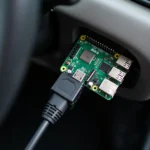Understanding the evolution of onboard diagnostics in your Honda is crucial, especially when it comes to troubleshooting and maintenance. This article dives deep into the differences between OBD1 and OBD2 systems specifically found in Honda vehicles, equipping you with the knowledge to make informed decisions about your car’s health.
Delving into the Past: Understanding OBD1 in Honda
Honda, like many other manufacturers, implemented the OBD1 system in response to the Clean Air Act Amendments of 1990. Active in most Honda models from 1992 to 1995, OBD1 primarily focused on monitoring the engine and emissions systems.
Here are key characteristics of Honda’s OBD1 system:
- Manufacturer-Specific Connectors: Unlike the standardized OBD2 connector, OBD1 utilized various connectors depending on the specific Honda model. This lack of uniformity often made it challenging to diagnose issues without specialized equipment.
- Basic Diagnostic Trouble Codes (DTCs): OBD1 systems employed simpler, less detailed DTCs compared to their OBD2 successors. These codes often required further interpretation using manufacturer-specific manuals or tools.
- Limited Self-Diagnostic Capabilities: OBD1 primarily illuminated the Check Engine Light to signal potential issues. It lacked the comprehensive self-diagnostic and data-logging capabilities of OBD2, making it harder to pinpoint the root cause of problems.
Embracing the Future: OBD2 in Honda Vehicles
Starting in 1996, Honda transitioned to the OBD2 (On-Board Diagnostics 2) system across its vehicle lineup. This shift brought significant advancements in diagnostics, standardizing the process and providing more comprehensive insights into your Honda’s performance.
Let’s explore the key features of OBD2 in Honda vehicles:
- Standardized 16-Pin Connector: OBD2 introduced a universal 16-pin connector located under the dashboard on the driver’s side, simplifying diagnostics and making it easier to connect external scan tools.
- Enhanced DTCs: OBD2 employs a standardized set of more detailed DTCs, offering greater specificity about the nature and location of potential malfunctions.
- Comprehensive Self-Diagnostics: This system continuously monitors various vehicle systems beyond just the engine and emissions. It can detect faults in areas such as the transmission, airbags, and anti-lock brakes.
- Live Data Stream: OBD2 enables access to real-time data from various sensors, providing valuable information about engine performance, fuel efficiency, and other crucial parameters.
OBD1 vs. OBD2 in Honda: Key Differences
| Feature | OBD1 | OBD2 |
|---|---|---|
| Connector | Manufacturer-specific | Standardized 16-pin |
| DTCs | Basic, less detailed | Enhanced, more specific |
| Self-Diagnostics | Limited, engine & emissions focused | Comprehensive, multiple systems |
| Data Stream | Not available | Real-time data from various sensors |



Navigating the Transition: OBD1 Motor in OBD2 Car Honda
While uncommon, some Honda enthusiasts might encounter a unique situation – an OBD1 engine swapped into an OBD2-compliant Honda chassis. This scenario presents challenges, as the two systems are not directly compatible. Addressing this requires careful wiring modifications and potentially aftermarket engine management systems to bridge the communication gap between the older engine and newer vehicle electronics.
Frequently Asked Questions about OBD1 and OBD2 Honda
Can I use an OBD2 scanner on my OBD1 Honda?
No, standard OBD2 scanners are not compatible with OBD1 systems due to the difference in connectors and communication protocols. Specialized adapters or older scan tools designed for OBD1 might be available but can be harder to find.
How do I know if my Honda has OBD1 or OBD2?
The most reliable way is to check the emissions sticker under the hood. It usually specifies the OBD standard for your vehicle. Additionally, Hondas manufactured from 1996 onwards are typically equipped with OBD2.
My Check Engine Light is on. What should I do?
If your Check Engine Light illuminates, it’s crucial to retrieve the diagnostic trouble codes (DTCs) using an appropriate OBD scanner. These codes provide insights into the potential issue and guide you towards a solution.
Conclusion
Understanding the nuances of OBD1 and OBD2 systems in Honda vehicles empowers you to take charge of your car’s maintenance and diagnostics. While OBD1 served as an essential stepping stone, OBD2 revolutionized automotive diagnostics with its standardization and comprehensive approach. If you need further assistance with your Honda’s diagnostics or require specialized knowledge, don’t hesitate to reach out to our team of experts via WhatsApp at +1(641)206-8880 or email us at [email protected]. We’re available 24/7 to provide expert guidance and address any questions you may have.

